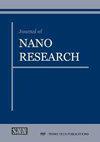Synthesis, Characterization, and Wear Behavior of W-DLC Films Deposited on Si Substrates
IF 1
4区 材料科学
Q4 MATERIALS SCIENCE, MULTIDISCIPLINARY
引用次数: 0
Abstract
Tungsten (W) reinforced diamond-like carbon (DLC) nanocomposite thin films were deposited on silicon substrates by magnetron sputtering in a CH4/Ar discharge. The W content of the films was varied by varying the W target power (20, 40, 60, 80, and 100 W). The evolution of the W-DLC nanocomposites was studied by high-resolution transmission electron microscopy, X-ray energy dispersive spectroscopy, X-ray photoelectron spectroscopy, 3D optical profilometry and Raman spectroscopy. Increasing the W target power resulted in an almost liner increase in the W content, reduced the hardness and the sp3/sp2 ratio in the films, while it increased the surface roughness and promoted formation of WC nanoparticles. Tribological properties were studied by conducting sliding reciprocating testing. Wear tracks were analyzed with Raman spectroscopy and 3D optical profilometry. Increasing the W content in the films (increasing target power) resulted in a reduction of both, the friction coefficient and wear rate. The film deposited at 80 W target power (~8 at. % W) exhibited the lowest friction coefficient (0.15) and wear rate (6x10-7 mm3N-1m-1). The observed low friction and wear rate were attributed to the particular nanocomposite structure of the films involving a fine distribution of WC nanoparticles surrounded by a sp2 dominant carbon network. The present W-DLC nanocomposite films offer a highly desirable combination of low friction and low wear rate.沉积在硅基片上的 W-DLC 薄膜的合成、表征和磨损行为
在 CH4/Ar 放电条件下,通过磁控溅射在硅基底上沉积了钨 (W) 增强类金刚石碳 (DLC) 纳米复合薄膜。通过改变 W 靶功率(20、40、60、80 和 100 W)来改变薄膜中的 W 含量。高分辨率透射电子显微镜、X 射线能量色散光谱、X 射线光电子能谱、三维光学轮廓仪和拉曼光谱对 W-DLC 纳米复合材料的演变进行了研究。增加 W 靶件功率几乎会导致 W 含量的直线上升,降低薄膜的硬度和 sp3/sp2 比率,同时增加表面粗糙度并促进 WC 纳米颗粒的形成。通过往复滑动测试研究了摩擦学特性。使用拉曼光谱和三维光学轮廓仪分析了磨损轨迹。增加薄膜中的 W 含量(增加目标功率)可降低摩擦系数和磨损率。目标功率为 80 W(~8% W)时沉积的薄膜显示出最低的摩擦系数(0.15)和磨损率(6x10-7 mm3N-1m-1)。所观察到的低摩擦系数和低磨损率归因于薄膜的特殊纳米复合结构,即 WC 纳米颗粒的精细分布被 sp2 主导碳网络所包围。目前的 W-DLC 纳米复合薄膜提供了非常理想的低摩擦和低磨损率组合。
本文章由计算机程序翻译,如有差异,请以英文原文为准。
求助全文
约1分钟内获得全文
求助全文
来源期刊

Journal of Nano Research
工程技术-材料科学:综合
CiteScore
2.40
自引率
5.90%
发文量
55
审稿时长
4 months
期刊介绍:
"Journal of Nano Research" (JNanoR) is a multidisciplinary journal, which publishes high quality scientific and engineering papers on all aspects of research in the area of nanoscience and nanotechnologies and wide practical application of achieved results.
"Journal of Nano Research" is one of the largest periodicals in the field of nanoscience and nanotechnologies. All papers are peer-reviewed and edited.
Authors retain the right to publish an extended and significantly updated version in another periodical.
 求助内容:
求助内容: 应助结果提醒方式:
应助结果提醒方式:


